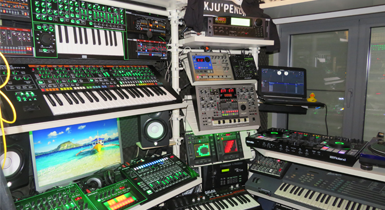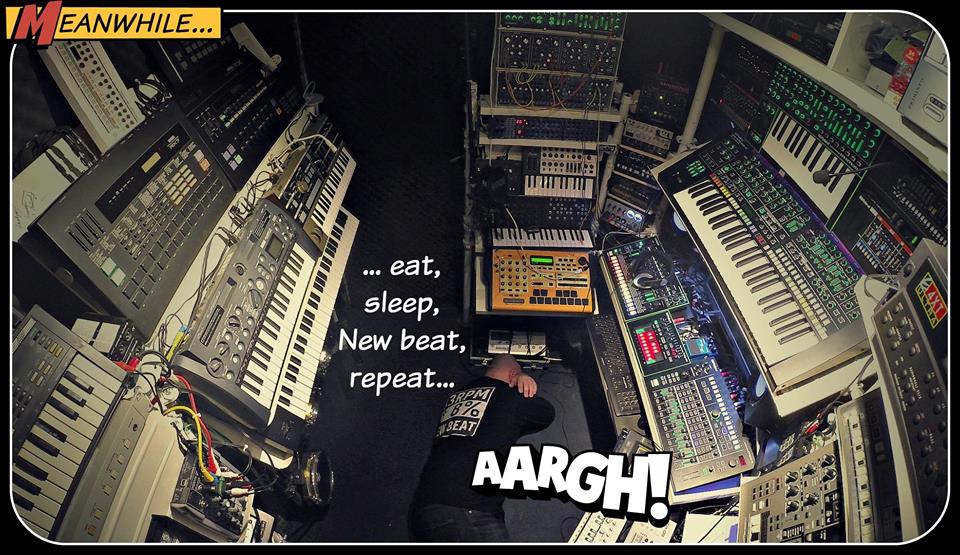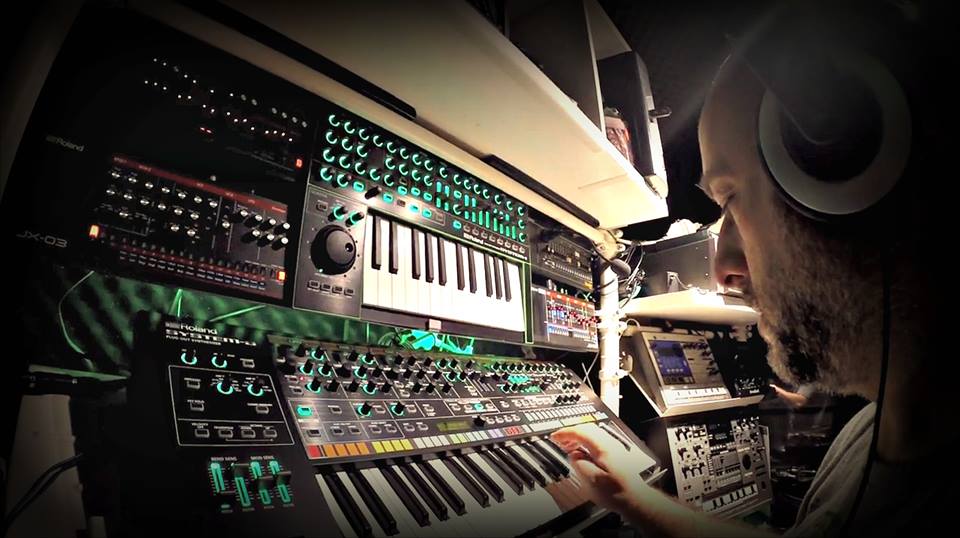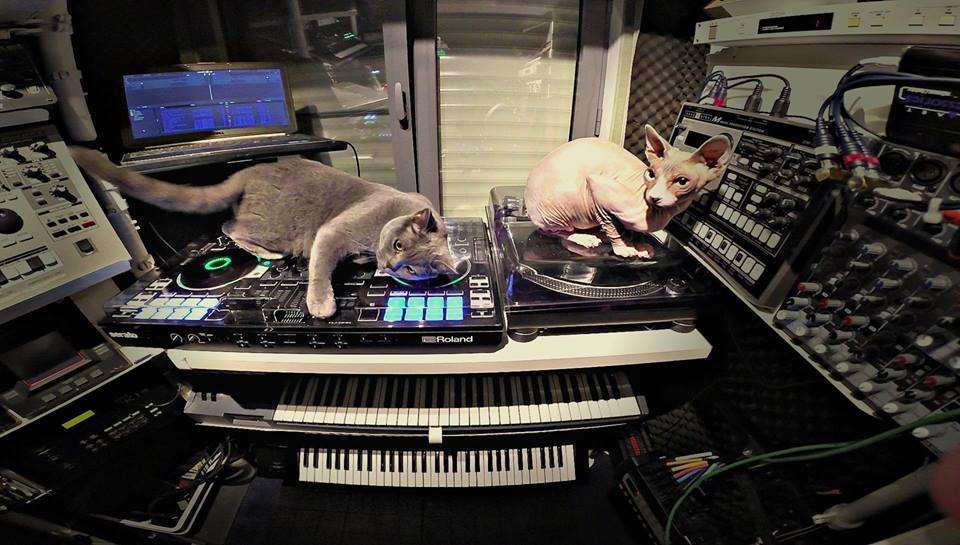Studio Interviews: Ceuppens Philippe (Q’pnz)
We’re in Belgium today where we chat with Ceuppens Philippe (Q’pnz) about his early love of synths and the unbelievable collection he possesses today… Interviewee: Ceuppens Philippe (Q’pnz), owner and manager of Q’pnz electronic dance studio Contact: dj-fille@telenet.be, Facebook, Youtube Website: www.qpnznewbeat.com MT: Tell us about your incredible setup? My studio is situated in Dendermonde […]

We’re in Belgium today where we chat with Ceuppens Philippe (Q’pnz) about his early love of synths and the unbelievable collection he possesses today…
Interviewee: Ceuppens Philippe (Q’pnz), owner and manager of Q’pnz electronic dance studio
Contact: dj-fille@telenet.be, Facebook, Youtube
Website: www.qpnznewbeat.com
MT: Tell us about your incredible setup?
My studio is situated in Dendermonde (Belgium) where I live. I started with my home studio about 20 years ago, but the interest in synthesizers/samplers/drum machines came at quite an early age. At the age of 7, I was learning to play the trumpet and wanted to find the right tones so I asked for a little toy synthesizer as birthday present. It was the Casio PT-1 and the rest is history.
It didn’t take long for the trumpet to come in second place and in no time I had a second toy keyboard, the Casio SK-5, which was a poor man’s sampler with 1.7 seconds of sampling time and 4 sample slots.
You cannot imagine the fun I had with these 2 “toy” keyboards as a child and I’ve made a lot of funny demo songs with them. I will keep them forever in my heart and they still are in my collection.
About 20 years ago I bought a Roland W-30 workstation as a first production tool, it’s a comprehensive package combining sequencer, keyboard controller and a 12-bit sampler (up to 14.4 seconds at a 30 khz sampling frequency or 28.8 seconds at 15 khz).
That moment was actually the start of a collaboration project with a friend, who was blown away from the W-30 and he decided to buy the same sampler keyboard. In the meantime, I was saving some money to buy a Roland MC-505 Groovebox, with lots of dance sounds, beats and effects., which I own now for almost 17 years. I hooked it all up to my computer and learned everything, by trial and error, about MIDI, which was necessary to use the full midi implementation that came with the 505.
Since then I’m busy expanding my equipment, recently Roland came out with the Aira and boutique series and these were so appealing to me that I’ve bought most of the Aira and boutique series, they are very ‘live performance’ oriented and I always enjoy playing and tweaking them.
MT: So the synthesiser itch got you early. We’re bracing ourselves now, what’s your gear rundown?
Two Dj sets
- Roland DJ-808
- 2 x Technics 1200 SL-Mk2 + Scratch Mixer: Stanton SA-12
Vintage hardware:
- Roland D-50 linear Synthesizer (1987)
- Roland W-30 Music Workstation (1989) – 12-Bit Sampler – sequencer
- Emu Emax-1 sampler with full 80’s sound library
- Roland MC-505 Groovebox
- Kawai K1M – Digital synthesizer
- Yamaha RX-7 – 80’s drummachine
- Yamaha RX-11 – 80’s drummachine
- Kawai R-50e – Industrial sounding drummachine (my favorite)
- Boss DR-550 – Drummachine
- Boss SE-50 – Stereo Effects Processor
- Casio PT-1 (my first toy keyboard ever!)
- Casio SK-5 – toy sampler keyboard, the poor man’s sampler
- Akai ME-30P -midipatchbay (A)
- Akai ME-80P -midipatchbay (B)
- Kenton – MIDI thru 5 – patchbay x 3
- Two Emu E4 XT Ultra Hardware samplers + SCSI Jaz, zip, CD, & optical drives (one for the studio and one for livegigs)
- Emu XL-7 Jamstation – External sequencer / groovebox (main sequencer for my live gigs)
Not so vintage or recent hardware:
- Akai MPX-8 simple trigger sampler for live gigs
- Korg MS-20 mini – Analog Monophonic synth (a true classic workhorse synth)
- Korg Electribe EA-1 – Analog Modeling Synthesizer
- Korg Monotribe – True Analog Ribbon Station Synthesizer – very brute bass synth!
- Korg Volca FM – Digital FM Synthesizer
- Korg Volca Kick – Analogue Kick generator
- Korg Kaossilator Pro+ Dynamic Phrase Synthesizer / Loop Recorder
- Korg Kaosspad KP3+ Multi effect controller/sampler
- Korg – Microkorg – Virtual analog synthesizer/Vocoder
- Two Novation A-Stations – Virtual analog Synthesizers
- Roland ” Boutique” series synth – JX-03
- Roland ” Boutique” series synth – JU-06
- Roland ” Boutique” series synth – JP-08
- Roland ” Boutique” series Rhythm Composer – TR-09
- Roland ” Boutique” series Bass Line Synth – TB-03
- Roland ” Boutique” series Vocoder – VP-03
- Roland ” Boutique” series Controller/ 8 bit generator – A-01
- Roland ” Boutique” series Analog synthesizer – SE-02
- Roland TD-3 drum module + self-made electronic drum triggers (trapkit)
- Roland Aira series – TR-8 – with update (TR808 -909-707-727-606)
- Roland Aira series – TB-3 – TB-303 clone + Boss BD2 Blues driver – distortion pedal for the TB-3 or TB-03
- Roland Aira series – System-1 – Virtual Analog synth
- Roland Aira series – System-1m – Virtual Analog Modular synth
- Roland System 500 series – Analog Modular system
- Roland Aira series – Modular effect boxes – Demora, Torcido, Bitrazor and Scooper
- Roland Aira series – MX-1 – Digital mixer, main soundcard.
- Teenage engineering po-12 – Rhythm
- Teenage engineering po-14 – Sub
- Teenage engineering po-16 – Factory
- Waldorf Blofeld Synth
- Waldorf Pulse 2 – Analog synth
- Waldorf Streichfett – Fat String synth
- Waldorf Rocket Synth – Fat Analog synth
- Microphones:
- AKG C-2000D
- Sennheiser e825s
- Sony Electret condenser
- Rode NT1-A
- TC Helicon Voicetone Harmony G- XT – Vocal harmonizer pedal
- TC Helicon Voicetone Correct XT – Vocal Processor
- Akai EIE Pro – 2nd Audio interface
- Yamaha HS-5 little active studio monitors + active subwoofer.
- DAW Cubase 8 with some freeware VSTi’s and following Roland Plugout VSTi synths:
- SH-1 Roland Plugout VSTi synth
- SH-101 Roland Plugout VSTi synth
- Promars Roland Plugout VSTi synth
- System 100 Roland Plugout VSTi synth
MT: Which DAW do you use and why?
I’m using Cubase 8. It’s my favourite sequencer and I’ve used Cubase since it came out on the Atari 1040 STe, my first computer, though back then Cubase was called twentyfour.
MT: What is your favourite piece of gear and why?
My favorite piece of gear is the Roland System 8, I like the fact that you can load the engines of super classic synths as the Jupiter 8 or Promars as plugouts and also the fact that it has loads of knobs, sliders and effects for sculpting the sound that you need or have in your head.
MT: How often would you say do you spend in your studio per week?
I’m mostly in the studio at night, I don’t really need a lot of sleep but my girlfriend does, so mostly 2 or three times in a week I go around 22.00 in the studio until 2 or 3 AM. In the weekend I spend some of my free time on mixing/mastering the pieces that I’ve made during the week.
MT: How do you use your studio?
Until 3 years ago I used the studio just for making music “for fun” but I also completely changed my setup around that time. To get to know the new gear, I made a few remixes of famous 80’s and 90’s songs and asked my Facebook followers to give me a few titles or propositions of songs to remake. So I’ve made a Facebook group for this where I posted the results.
The reactions were very positive and somebody asked me to do a remix of a classic Belgian New Beat song.
As I was myself a big fan of the new beat (I started to go out to that music when I was 16 at the end of the 80’s) I decided instead not to remix a known song but I made a new “new beat” song with the sounds of yesteryear, it had such a success on Facebook and since then I mostly make 80’s sounding industrial EBM or New Beat. I was even contacted by a label (fenixfirerecords) and one of my songs appeared on a vinyl new beat compilation called “fashion victims”.
For the moment I’m working on a full industrial EBM album and already released a demo cd on my own (only 130 copy’s for the diehard fans). I have also plans to start an industrial EBM live group (front 242 influenced) so I’m still looking for the right people to collaborate with, just send me an e-mail if you’re interested.
[Modula id=’8′]
MT: What is next on your shopping list studio wise and why?
As I’m a very big fan of the Roland Boutique series, I’m awaiting the SH-01a, the TR-08 and the D-05. I already have the D-50 but I use it so much in my productions (typical 80’s sound) that a mini D-50 module with sequencer is always welcome. On the original is no sequencer. The SH-101 was one of the synths I always wanted when I was 18 but I’ve made the mistake to buy a guitar instead, I always regretted this and now is the chance to obtain one.
MT: Anything annoy you about your set-up and why?
The only thing that annoys me sometimes is the lack of inputs on the Roland mx-1 mixer/soundcard. I work with different submixers to bring all that gear into the mx-1 but as they keep releasing these boutiques/Aira gear (which I like very much!) there is a need for more inputs – analog as digital Aira USB – or some sort of “overhub” Aira thing. It’s time that Roland comes out with an MX-2 I think, on the contrary I really like to work with the mx-1 especially as a live performance mixer.
MT: What is your dream piece of gear and why?
I think I have everything I ever wanted and enjoy it for the full 100%! For most people I think it’s some analog classic monster synth they want, for me the whole analog/digital debate on some Facebook groups or music forums is b*llsht to me. I think people should be happy with all those remakes of these classic machines and instead of arguing about that it’s not 100% sounding exact, they better start making music.
MT: What is your top piece of production advice?
My production advice is to know your gear. Sometimes it takes some time to know all the ins and outs from new gear, but if you want to use something at its full potential you need to RTFM (read the f*cking manual for the unfamiliar). I’m sure a lot of musicians don’t know the half of what their equipment can do. And if you come to your gear’s limitations, it’s not a bad thing to look for a solution or workaround.
I have a bunch of material and I plead guilty of having the GAS syndrome but I really can produce a good song with only one piece of equipment. I just want to say if you want to produce music, it doesn’t have to be on expensive or a lot of gear, you just need to know that gear inside and out.
MT: What is the one piece of advice you would give someone starting out building a studio?
A really good starting point for figuring out what gear you need/want is http://tweakheadz.com/, which I used also a lot back in the day, where you can also find a lot of the basics explained like MIDI etc. Thanks goes to Rich theTweakmeister.


